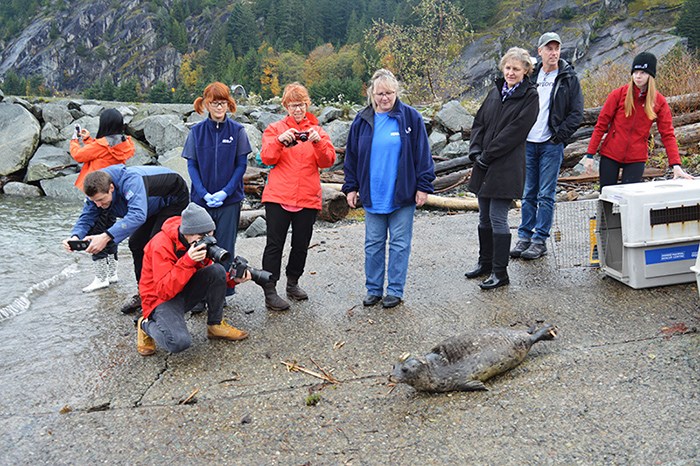Four harbour seal pups returned to the waters Friday morning as Vancouver Aquarium staff and volunteers released them at Porteau Cove after rehabilitation.
The four – Ziggy, Sinbad, Siberia and Bubbles – are three to four months old and are part of the aquarium’s marine mammal rescue program.
When it came time to release the four pups from their crates, one of them crawled down the ramp of the boat launch, taking to the waters immediately, while the others needed a little coaxing, specifically tipping, to get them to come out of the crates.
“Some of them are hesitant to leave, but we usually see that,” said Lindsaye Akhurst, manager of the Vancouver Aquarium Marine Mammal Rescue Centre.
Before long, though, each was swimming around the waters of Porteau Cove, occasionally coming up on the rocks or bobbing its head above the waterline for a look back at the shore.
The aquarium chose Porteau Cove for a few reasons, such as its accessibility, but primarily because it is already a habitat for harbour seals.
“This is a spot where harbour seals normally live,” said Martin Haulena, a Vancouver Aquarium veterinarian. “It’s fairly secluded.”
Typically, a seal should be released within 50 kilometres of where it was found. In this case, the animals came from Comox, Fanny Bay, Cowichan Bay and Sechelt. Each of the four was discovered after having been separated from its mother.
The program provides rehabilitation for many marine animals, but harbour seals are the most common ones treated. While the main goal of the program is to nurse the animals back to health, there are other benefits, especially for the aquarium’s students.
“It’s an opportunity to do research for students,” Haulena said.
As part of the release, the seal pups have been tagged so they can be monitored by satellite. The transmitter is attached with an epoxy designed to fall off after several months, or at least near the time the seals moult each year.
As Haulena said during a media briefing, the idea is to monitor the seal pups over the next few months to see whether each is adapting to the wild, especially with threats posed by orcas, other animals and disease.
“We can’t expect 100 per cent success,” Haulena said.
The website allows anyone to monitor the animals online on the Marine Mammal Rescue Centre’s tracking page.
“It’s really fun to follow,” Akhurst said. “You’ll see an approximate location of each seal.”
While the four were released at the same time, it is unlikely they will stay together in a pack for any length of time.
“They all go different directions just about right away,” Haulena said.
Overall, the centre has had 162 seal pups this year. Of these, 70 have been returned to the wild, with many still at the centre. Some come in injured but many are there because they have become separated from the mother and typically need to be nursed back to health and taught how to fish.
The centre treats more than 100 marine mammals each year. This year, it worked with other animals including a fur seal, a sea lion and a green sea turtle, which was released to the wild on Thursday in San Diego after finishing its treatment for cold stunning, or hypothermia, at Sea World.
Still, the harbour seals make up the largest part of the program.
“The majority of the animals that come in our centre are harbour seal pups,” Akhurst said.



